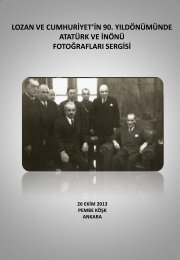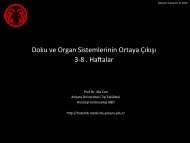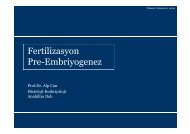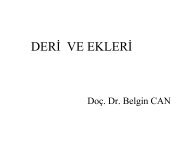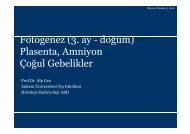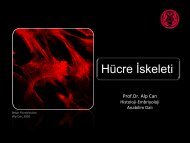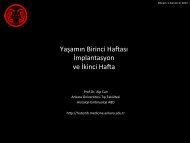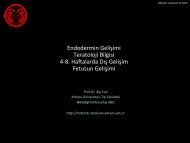dosya indir - ankaratiphastaneleri
dosya indir - ankaratiphastaneleri
dosya indir - ankaratiphastaneleri
You also want an ePaper? Increase the reach of your titles
YUMPU automatically turns print PDFs into web optimized ePapers that Google loves.
S126<br />
D. Blarent ve ark.<br />
on stridor, is age dependent inchildren. Crit Care Med 2002;<br />
30:2639-43.<br />
72. Katz SH, Falk JL. Misplaced endotracheal tubes by paramedics<br />
in an urban emergency medical services system. Ann Emerg<br />
Med 2001; 37:32-7.<br />
73. Gausche M, Lewis RJ, Stratton SJ, et al. Effect of out-of-hospital<br />
pediatric endotracheal intubation on survival and neurological<br />
outcome: a controlled clinical trial. JAMA 2000; 283:783-<br />
90.<br />
74. Kelly JJ, Eynon CA, Kaplan JL, de Garavilla L, Dalsey WC. Use<br />
of tube condensation as an indicator of endotracheal tube placement.<br />
Ann Emerg Med 1998; 31:575-8.<br />
75. Andersen KH, Hald A. Assessing the position of the tracheal<br />
tube: the reliability of different methods. Anaesthesia 1989;<br />
44:984-5.<br />
76. Andersen KH, Schultz-Lebahn T. Oesophageal intubation can<br />
be undetected by auscultation of the chest. Acta Anaesthesiol<br />
Scand 1994; 38:580-2.<br />
77. Hartrey R, Kestin IG. Movement of oral and nasal tracheal tubes<br />
as a result of changes in head and neck position. Anaesthesia<br />
1995; 50:682-7.<br />
78. Van de Louw A, Cracco C, Cerf C, et al. Accuracy of pulse oximetry<br />
in the intensive care unit. Intensive Care Med 2001;<br />
27:1606-13.<br />
79. Seguin P, Le Rouzo A, Tanguy M, Guillou YM, Feuillu A, Malledant<br />
Y. Evidence for the need of bedside accuracy of pulse<br />
oximetry in an intensive care unit. Crit Care Med 2000;<br />
28:703-6.<br />
80. Tan A, Schulze A, O'Donnell CP, Davis PG. Air versus oxygen<br />
for resuscitation of infants at birth. Cochrane Database Syst Rev<br />
2004: CD002273.<br />
81. Ramji S, Rasaily R, Mishra PK, et al. Resuscitation of asphyxiated<br />
newborns with room air or 100% oxygen at birth: a multicentric<br />
clinical trial. Indian Pediatr 2003; 40:510-7.<br />
82. Vento M, Asensi M, Sastre J, Garcia-Sala F, Pallardo FV, Vina J.<br />
Resuscitation with room air instead of 100% oxygen prevents<br />
oxidative stress in moderately asphyxiated term neonates. Pediatrics<br />
2001; 107:642-7.<br />
83. Saugstad OD. Resuscitation of newborn infants with room air<br />
or oxygen. Semin Neonatol 2001; 6:233-9.<br />
84. Aufderheide TP, Lurie KG. Death by hyperventilation: a common<br />
and life-threatening problem during cardiopulmonary resuscitation.<br />
Crit Care Med 2004; 32:S345-51.<br />
85. Aufderheide TP, Sigurdsson G, Pirrallo RG, et al. Hyperventilation-induced<br />
hypotension during cardiopulmonary resuscitation.<br />
Circulation 2004; 109:1960-5.<br />
86. Wik L, Kramer-Johansen J, Myklebust H, et al. Quality of cardiopulmonary<br />
resuscitation during out-of-hospital cardiac arrest.<br />
JAMA 2005; 293:299-304.<br />
87. Abella BS, Alvarado JP, Myklebust H, et al. Quality of cardiopulmonary<br />
resuscitation during in-hospital cardiac arrest. JA-<br />
MA 2005; 293:305-10.<br />
88. Abella BS, Sandbo N, Vassilatos P, et al. Chest compression rates<br />
during cardiopulmonary resuscitation are suboptimal: a<br />
prospective study during in-hospital cardiac arrest. Circulation<br />
2005; 111:428-34.<br />
89. Borke WB, Munkeby BH, Morkrid L, Thaulow E, Saugstad OD.<br />
Resuscitation with 100 % O(2) does not protect the myocardium<br />
in hypoxic newborn piglets. Arch Dis Child Fetal Neonatal<br />
Ed 2004; 89:F156-60.<br />
90. Stockinger ZT, McSwain NE, Jr. Prehospital endotracheal intubation<br />
for trauma does not improve survival over bag-valfemask<br />
ventilation. J Trauma 2004; 56:531-6.<br />
91. Pitetti R, Glustein JZ, Bhende MS. Prehospital care and outcome<br />
of pediatric out-ofhospital cardiac arrest. Prehosp Emerg<br />
Care 2002; 6:283-90.<br />
92. Cooper A, DiScala C, Foltin G, Tunik M, Markenson D, Welborn<br />
C. Prehospital endotracheal intubation for severe head injury in<br />
children: a reappraisal. Semin Pediatr Surg 2001; 10:3-6.<br />
93. Bhende MS, Thompson AE, Cook DR, Saville AL. Validity of a<br />
disposable end-tidal CO2 detector in verifying endotracheal<br />
tube placement in infants and children. Ann Emerg Med 1992;<br />
21:142-5.<br />
94. Bhende MS, Thompson AE, Orr RA. Utility of an end-tidal carbon<br />
dioxide detector during stabilization and transport of critically<br />
ill children. Pediatrics 1992; 89(pt1):1042-4.<br />
95. Bhende MS, LaCovey DC. End-tidal carbon dioxide monitoring<br />
in the prehospital setting. Prehosp Emerg Care 2001; 5:208-<br />
13.<br />
96. Ornato JP, Shipley JB, Racht EM, et al. Multicenter study of a<br />
portable, hand-size, colorimetric end-tidal carbon dioxide detection<br />
device. Ann Emerg Med 1992; 21:518-23.<br />
97. Gonzalez del Rey JA, Poirier MP, Digiulio GA. Evaluation of an<br />
ambu-bag valfe with a self-contained, colorimetric end-tidal<br />
CO2 system in the detection of airway mishaps: an animal trial.<br />
Pediatr Emerg Care 2000; 16:121-3.<br />
98. Bhende MS, Thompson AE. Evaluation of an end-tidal CO2 detector<br />
during pediatric cardiopulmonary resuscitation. Pediatrics<br />
1995; 95:395-9.<br />
99. Bhende MS, Karasic DG, Karasic RB. End-tidal carbon dioxide<br />
changes during cardiopulmonary resuscitation after experimental<br />
asphyxial cardiac arrest. Am J Emerg Med 1996;<br />
14:349-50.<br />
100. DeBehnke DJ, Hilander SJ, Dobler DW, Wickman LL, Swart GL.<br />
The hemodynamic and arterial blood gas response to asphyxiation:<br />
a canine model of pulseless electrical activity. Resuscitation<br />
1995; 30:169-75.<br />
101. Ornato JP, Garnett AR, Glauser FL. Relationship between cardiac<br />
output and the end-tidal carbon dioxide tension. Ann<br />
Emerg Med 1990;19:1104-6.<br />
102. Sharieff GQ, Rodarte A, Wilton N, Silva PD, Bleyle D. The selfinflating<br />
bulb as an esophageal detector device in children weighing<br />
more than twenty kilograms: A comparison of two<br />
techniques. Ann Emerg Med 2003; 41:623-9.<br />
103. Sharieff GQ, Rodarte A, Wilton N, Bleyle D. The self-inflating<br />
bulb as an airway adjunct: is it reliable in children weighing<br />
less than 20 kilograms? Acad Emerg Med 2003; 10:303-8.<br />
104. Poirier MP, Gonzalez Del-Rey JA, McAneney CM, DiGiulio GA.<br />
Utility of monitoring capnography, pulse oximetry, and vital<br />
signs in the detection of airway mishaps: a hyperoxemic animal<br />
model. Am J Emerg Med 1998; 16:350-2.<br />
105. Lillis KA, Jaffe DM. Prehospital intravenous access in children.<br />
Ann Emerg Med 1992; 21:1430-4.<br />
106. Kanter RK, Zimmerman JJ, Strauss RH, Stoeckel KA. Pediatric<br />
emergency intravenous access. Evaluation of a protocol. Am J<br />
Dis Child 1986; 140:132-4.<br />
107. Banerjee S, Singhi SC, Singh S, Singh M. The intraosseous route<br />
is a suitable alternative to intravenous route for fluid resuscitation<br />
in severely dehydrated children. Indian Pediatr 1994;<br />
31:1511-20.<br />
108. Glaeser PW, Hellmich TR, Szewczuga D, Losek JD, Smith DS.<br />
Five-year experience in prehospital intraosseous infusions in<br />
children and adults. Ann Emerg Med 1993; 22:1119-24.<br />
109. Guy J, Haley K, Zuspan SJ. Use of intraosseous infusion in the<br />
pediatric trauma patient. J Pediatr Surg 1993; 28:158-61.<br />
110. Orlowski JP, Julius CJ, Petras RE, Porembka DT, Gallagher JM.<br />
The safety of intraosseous infusions: risks of fat and bone marrow<br />
emboli to the lungs. Ann Emerg Med 1989; 18:1062-7.<br />
111. Orlowski JP, Porembka DT, Gallagher JM, Lockrem JD, VanLente<br />
F. Comparison study of intraosseous, central intravenous,<br />
and peripheral intravenous infusions of emergency drugs. Am<br />
J Dis Child 1990; 144:112-7.<br />
112. Abe KK, Blum GT, Yamamoto LG. Intraosseous is faster and easier<br />
than umbilical venous catheterization in newborn emergency<br />
vascular access models. Am J Emerg Med 2000;<br />
18:126-9.<br />
113. Ellemunter H, Simma B, Trawoger R, Maurer H. Intraosseous lines<br />
in preterm and full term neonates. Arch Dis Child Fetal Neonatal<br />
Ed 1999; 80:F74-F5.<br />
114. Cameron JL, Fontanarosa PB, Passalaqua AM. A comparative



